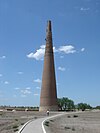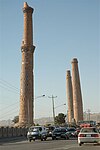
Bukhara is the seventh-largest city in Uzbekistan, with a population of 280,187 as of 1 January 2020, and the capital of Bukhara Region. The mother tongue of the majority of people of Bukhara is the Tajik dialect of the Persian language, although Uzbek is spoken as a second language by most residents.

A minaret is a type of tower typically built into or adjacent to mosques. Minarets are generally used to project the Muslim call to prayer (adhan) from a muezzin, but they also served as landmarks and symbols of Islam's presence. They can have a variety of forms, from thick, squat towers to soaring, pencil-thin spires.
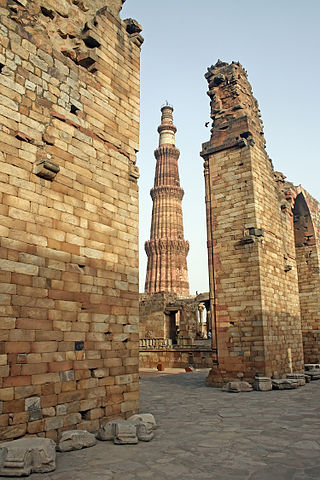
The Qutb Minar complex are monuments and buildings from the Delhi Sultanate at Mehrauli in Delhi, India. Construction of the Qutub Minar "victory tower" in the complex, named after the religious figure Sufi Saint Khwaja Qutbuddin Bakhtiar Kaki, was begun by Qutb-ud-din Aibak, who later became the first Sultan of Delhi of the Mamluk dynasty. It was continued by his successor Iltutmish, and finally completed much later by Firoz Shah Tughlaq, a Sultan of Delhi from the Tughlaq dynasty (1320–1412) in 1368 AD. The Qubbat-ul-Islam Mosque, later corrupted into Quwwat-ul Islam, stands next to the Qutb Minar.

Minar-e-Pakistan is a tower located in Lahore, Punjab, Pakistan. The tower was built between 1960 and 1968 on the site where the All-India Muslim League passed the Lahore Resolution on 23 March 1940 - the first official call for a separate and independent homeland for the Muslims of British India, as espoused by the two-nation theory. The resolution eventually helped lead to the creation of Pakistan in 1947.
The Qutb Minar, also spelled Qutub Minar and Qutab Minar, is a minaret and "victory tower" that forms part of the Qutb complex, which lies at the site of Delhi's oldest fortified city, Lal Kot, founded by the Tomar Rajputs. It consists of 399 steps It is a UNESCO World Heritage Site in the Mehrauli area of South Delhi, India. It is one of the most visited tourist spots in the city, mostly built between 1199 and 1220.

Iranian architecture or Persian architecture is the architecture of Iran and parts of the rest of West Asia, the Caucasus and Central Asia. Its history dates back to at least 5,000 BC with characteristic examples distributed over a vast area from Turkey and Iraq to Uzbekistan and Tajikistan, and from the Caucasus to Zanzibar. Persian buildings vary greatly in scale and function, from vernacular architecture to monumental complexes. In addition to historic gates, palaces, and mosques, the rapid growth of cities such as the capital Tehran has brought about a wave of demolition and new construction.

The Burana Tower is a large minaret in the Chüy Valley in northern Kyrgyzstan. It is located about 80 km east of the country's capital Bishkek, near the town of Tokmok. The tower, along with grave markers, some earthworks and the remnants of a castle and three mausoleums, is all that remains of the ancient city of Balasagun, which was established by the Karakhanids at the end of the 9th century. The tower was built in the 11th century and was used as a template for other minarets. An external staircase and steep, winding stairway inside the tower enables visitors to climb to the top. It is one of the oldest architectural constructions in Central Asia.

The Minaret of Jam is a UNESCO World Heritage Site in western Afghanistan. It is located in a remote and nearly inaccessible region of the Shahrak District, Ghor Province, next to the Hari River. The 62 m (203 ft) or 65 m (213 ft) high minaret was built c. 1190 entirely of baked bricks and is famous for its intricate brick, stucco and glazed tile decoration, which consists of alternating bands of kufic and naskhi calligraphy, geometric patterns, and verses from the Qur'an. Since 2002, the minaret has remained on the list of World Heritage in Danger, under serious threat of erosion, and has not been actively preserved. In 2014, the BBC reported that the tower was in imminent danger of collapse.
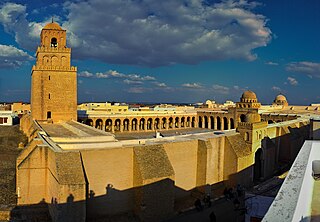
The Great Mosque of Kairouan, also known as the Mosque of Uqba, is a mosque situated in the UNESCO World Heritage town of Kairouan, Tunisia and is one of the most impressive and largest Islamic monuments in North Africa.

Architecture of Central Asia refers to the architectural styles of the numerous societies that have occupied Central Asia throughout history. These styles include a regional tradition of Islamic and Iranian architecture, including Timurid architecture of the 14th and 15th centuries, as well as 20th-century Soviet Modernism. Central Asia is an area that encompasses land from the Xinjiang Province of China in the East to the Caspian Sea in the West. The region is made up of the countries of Kazakhstan, Uzbekistan, Tajikistan, Kyrgyzstan, and Turkmenistan. The influence of Timurid architecture can be recognised in numerous sites in Kazakhstan and Uzbekistan, whilst the influence of Persian architecture is seen frequently in Uzbekistan and in some examples in Turkmenistan. Examples of Soviet architecture can be found in Uzbekistan, Kazakhstan, Tajikistan and Kyrgyzstan.

The Musalla complex, also known as the Musallah Complex or the Musalla of Gawhar Shah, is a former Islamic religious complex located in Herat, Afghanistan, containing examples of Timurid architecture. Much of the 15th-century complex is in ruins today, and the buildings that still stand are in need of restoration. The complex ruins consist of the five Musallah Minarets of Herat, the Mir Ali Sher Navai mausoleum, the Gawhar Shad Mausoleum, and the ruins of a large mosque and a madrasa complex.

The Minar was a staged, tower-like structure built in the center of the Sasanian circular city of Gōr. Several theories have been proposed for its purpose. Only the core of the structure remains today.

Kutlug Timur minaret is a minaret in Konye-Urgench in north Turkmenistan, Central Asia. It was built in 1011 during the Khwarazmian dynasty. The height of the minaret is 60 meters with a diameter of 12 metres at the base and 2 metres at the top. In 2005, the ruins of Old Urgench where the minaret is located were inscribed on the UNESCO List of World Heritage Sites.
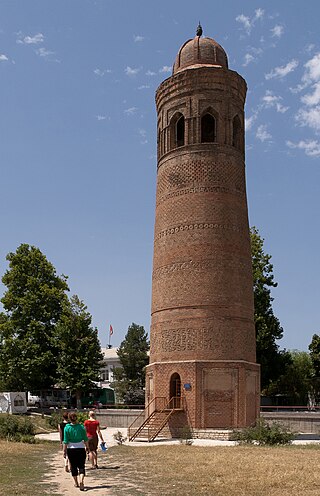
The Uzgen Minaret also spelled as Özgön Minar or Uzgend Minaret is an 11th-century minaret tower located in Uzgen, Kyrgyzstan. It forms part of the ancient ruins in Uzgen along with three well preserved mausoleums located nearby. Uzgen Minaret is a 27.5 metres tall tapering tower, with an 8.5 metres base diameter, reducing to 6.2 metres at the top.

The Ghazni Minarets are two elaborately decorated minaret towers located in Ghazni city, central Afghanistan. They were built in middle of the twelfth century and are the only surviving elements of the mosque of Bahram Shah. The two minarets are 600 meters apart and lie in an open plain, north-east of Ghazni city.

The Eger minaret is an Ottoman-era minaret tower located in Eger city, northern Hungary. It is one of the most northern minarets left from Ottoman rule in Europe. The minaret is 40 metres high and built from red sandstone. It was built in the early 17th century as part of the Djami of Kethuda mosque and used for the Muslim call to prayer (Adhan). The mosque no longer exists, but the minaret survives as a preserved monument of Hungary and a major tourist attraction of Eger. There are 98 steps on the spiral staircase inside, which leads to a balcony at 26 meters from the ground, offering unique views of the surrounding city.
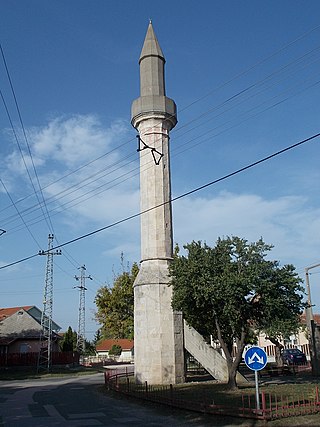
The Érd minaret is an Ottoman era minaret tower situated in Érd near capital Budapest in Hungary. It is one of only three Ottoman era minarets still surviving in Hungary. The other two are the Eger minaret and the minaret of Yakovalı Hasan Paşa Mosque in Pécs.

The architecture of Tunisia began with the ancient civilizations such as the Carthaginians, Numidians, and Romans. After the 7th century, Islamic architecture developed in the region under a succession of dynasties and empires. In the late 19th century French colonial rule introduced European architecture, and modern architecture became common in the second half of the 20th century. The southern regions of the country are also home to diverse examples of local vernacular architecture used by the Berber (Amazigh) population.


